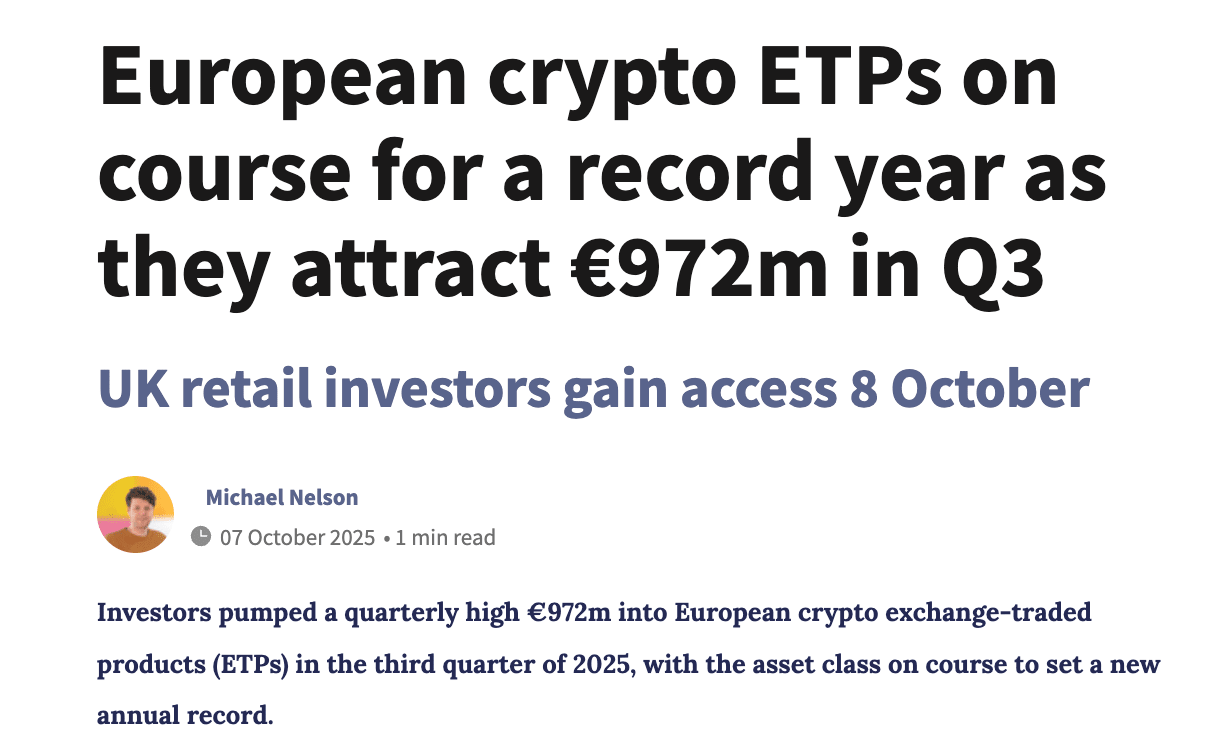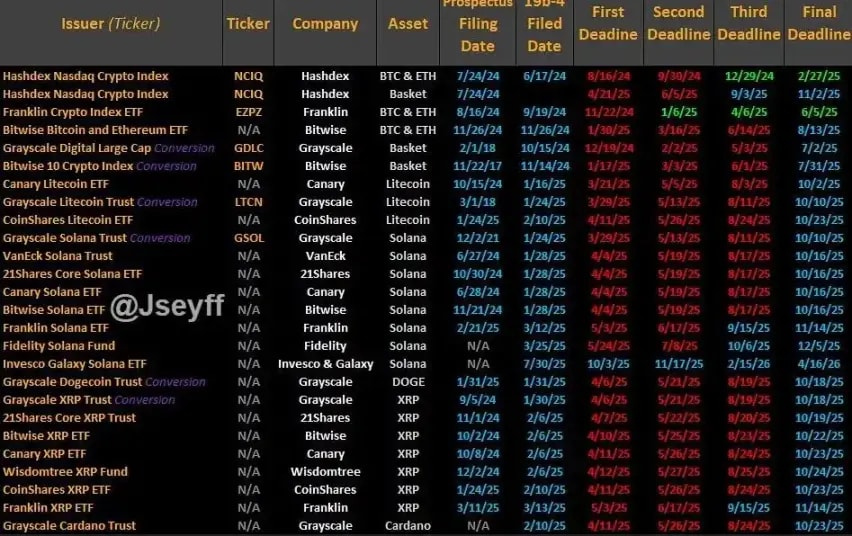By Tristero Research
Compiled by: Vernacular Blockchain


In September 2025, the US crypto market suddenly shifted. For years, launching a new fund meant navigating 240 days of regulatory purgatory. Each product was a customized battle with the US Securities and Exchange Commission (SEC). Then, with a single vote, the SEC replaced the old rulebook with a stopwatch.
By approving universal listing standards for commodity trust shares, the SEC has created a fast track for crypto exchange-traded products (Altcoin). What once took eight months now takes just two. The result: a deadline jam, with more than a dozen alternative token ETFs, from Solana to Dogecoin, all waiting for a decision within the same narrow window.
Welcome to ETF Month.
New game rules
Previously, crypto ETFs required a "19b-4" rule change—each a custom request. The new system eliminates this step for assets that pass a clear, rules-based test. The "golden ticket"—the financial world's equivalent of TSA PreCheck—is a futures market regulated by the U.S. Commodity Futures Trading Commission (CFTC) with at least six months of trading history.
This test created a de facto cryptocurrency caste system:
- The first tier: Bitcoin and Ethereum already have spot ETFs that have made a splash in the market.
- Second tier: Assets like Solana, XRP, and Cardano, which have futures markets, unlocking the fast lane.
- The third tier: All other currencies are still stuck in the slow lane.
This is a shift from “regulation through enforcement” to “regulation through infrastructure.” The SEC no longer debates the utility of a coin, but rather asks: Is it traded in a mature, regulated market?
October schedule
The new regulations have created a busy October schedule:
- October 10: Grayscale Trust Switch (Solana, Litecoin).
- October 16: Spot Solana ETF decision (21Shares, Bitwise).
- October 18–25: XRP ETF approvals expected, with at least one almost certain to get the green light.
- Also in the queue are: Cardano (Grayscale's GADA), Dogecoin, Avalanche, and Hedera.
The biggest cultural signal is Dogecoin. Whether or not it's a meme coin, DOGE qualifies because it has a regulated futures market. The new framework is neutral; it only cares about data.

This first wave also drives the next regulatory frontier: staking. Several Solana filings propose passing returns to investors through staking fund assets. If approved, ETFs would evolve from passive tracking tools to income-generating products—a direct bridge between Wall Street financial products and the on-chain economy.
Capital Flows
Funds are already flowing, but unevenly. Institutional players are making their moves, while retail traders are hesitant.
- Institutional: Open interest in XRP futures on the Chicago Mercantile Exchange (CME) has exceeded $1 billion, a typical sign that big money is preparing for a new investment tool.
- Retail investors: More than $1.9 billion in XRP liquidations during the same period show that small traders are repeatedly harvested during fluctuations.
The conclusion is: the early ETF wave will be a migration of existing institutional exposure to clearer, cheaper, and regulated financial products. This wave of alternative token ETPs is more about optimizing market structure than unleashing new demand.
Global Competition
The United States is not the only country opening up its crypto market; this is a global race.
Europe: 21Shares and CoinShares already offer basket products and alternative token ETPs (in Switzerland since 2018).

Hong Kong: A structural innovator, allowing “in-kind” subscriptions and redemptions (trading ETF shares with actual cryptocurrencies). The United States initially banned this approach, but in July 2025, it allowed in-kind subscriptions and redemptions for Bitcoin and Ethereum, marking a convergence.

United States: Now leveraging its scale advantages but setting barriers to entry through regulated futures markets.
Potential risks
This sudden expansion brings both opportunities and risks.
Dilution vs. Rising Tide Lifts All Boats
The launch of a Bitcoin ETF is a prime example of a rising tide lifting all boats. However, dozens of alternative token ETFs could fragment capital flows, with the majority of capital concentrated in the cheapest, most branded products. Smaller issuers risk being marginalized.
Liquidity pressure
The liquidity of an ETF ultimately relies on the underlying spot market. For smaller alternative tokens, a surge in redemptions during a market downturn could put pressure on market makers, causing the ETF's trading price to deviate from its net asset value.
Big Screening
ETP eligibility is rapidly becoming a hallmark of legitimacy. "Blue-chip" cryptocurrencies with futures markets attract institutional money, while thousands of other cryptocurrencies are shut out. This widens the gap between investable mainstream cryptocurrencies and speculative, long-tail assets.
Conclusion: The beginning of a new era
The October 2025 date is a direct result of a regulatory shift that compresses years of product development into a matter of weeks.
The month of ETFs is the first proof of concept for the new issuance mechanism. The US crypto market has graduated from the Bitcoin/Ethereum era to a broader, more complex, and more accessible ecosystem.
The floodgates have opened – and the scramble for capital, liquidity and legitimacy has only just begun.
Link to this article: https://www.hellobtc.com/kp/du/10/6073.html
Source: https://tristero.substack.com/p/the-october-eth-month








